Article and photos by Joe Sapia
Note: The yard references are to my house in the section of Monroe between Helmetta and Jamesburg in South Middlesex County. My yard is in a Pine Barrens outlier on the Inner Coastal Plain, the soil is loamy, and my neighborhood is on the boundary of Gardening Zones 6b (cooler) and 7a (warmer). Afield references are to the Pine Barrens around Helmetta, unless otherwise noted. Notes and photographs are for the period covered, unless otherwise noted.
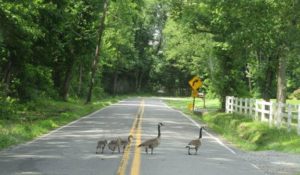
Mama and Papa Canada geese, “Branta canadensis,” and their young cross a road in the Dayton section of South Brunswick, Middlesex County, and stop my Jeep in its tracks. Silly geese! (On a serious note, humans could learn from the dedicated parenting of Canada geese.)
GOOD TO BE BACK HOME: Sorry for missing last week’s “Garden and Afield,” but I was down in New Orleans or traveling to and from. I was attending receptions for a medical residency graduation (of Dr. Anthony M. Sciascia II, the son of my college buddy) and wedding (of Anthony and Nancy). I had a wonderful time with the Sciascia clan who has treated me as family since our Marquette University days that began more than 40 years ago. But I always enjoy getting back home….
SOME N’AWLINS FLAVOR IN THE JERSEY MIDLANDS: New Orleans is known for its coffee made from the roots of chicory, “Cichorium intybus.” Well, guess what has began blooming in the Jersey Midlands? Chicory, the blue flower along roadsides and other disturbed areas. It is a foreign species naturalized here. That is, a weed. But a weed with a nice-looking flower.
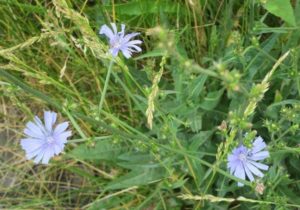
Chicory growing on a Monroe roadside.
IN THE GARDEN: While I was gone, my garden did not get its daily watering, even more critical because we had some very hot temperatures, near 100! But I began harvesting lettuce in earnest.
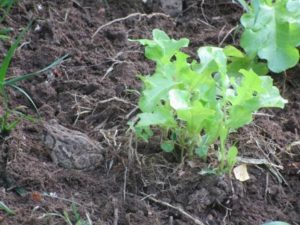
Lake Valley Seeds’s “Salad Bowl Green Heirloom Lettuce” grows in my garden. Next to the lettuce is nature’s pesticide, a toad — probably an American toad, “Anaxyrus americanus.” (Thanks to Sam Skinner, a Monmouth County Park System naturalist who set me in the right direction on the tentative identification of this toad.)
MY ORGANIC GARDEN: I just mentioned the wild toad as a natural pesticide. But, nowadays, people seem to be touchy over the term “organic,” arguing its meaning or arguing that “organic” does not mean purely natural. As I was taught in journalism, say exactly what you mean, rather than using labels. So, here is how I food garden – I add nothing to the mix except water.
MANALAPAN BROOK: The Brook flows about 400 feet from my front yard, but, thankfully, I am about 150 feet from its floodplain – so, close enough to enjoy the waterway, but far enough away not to be affected by flooding. This time of year, the Brook has a summer feel, with lush vegetation growing in the floodplain and, on this day, bright sunlight creeping through the trees. My section of the Brook is between “Jamesburg Lake” (Lake Manalapan) and “Spotswood Lake” (DeVoe Lake). Its watershed drains 40.7 square miles, according to the United States Geological Survey, in Middlesex and Monmouth Counties.
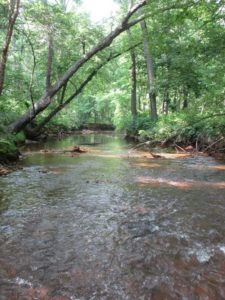
Manalapan Brook, looking downstream toward Helmetta
LIGHTNING BUGS: I saw the first lightning bug, a member of the “Lampyridae” insect family, of the season June 4. On June 17, as I was putting together this “Garden and Afield,” I watched fireflies in my backyard. There seemed to be more than normal, maybe a half-dozen to a dozen, but not the numbers I remember when I was a kid. They flash to signal mates.
ELSEWHERE IN THE YARD: Also in the yard over the last two weeks were rabbit, genus “Lepus”; the state bird, the Eastern goldfinch, “Spinus tristis,”; and my friend, the catbird, “Dumetella carolinensis.” The rabbits allow me to get within a few feet of them, probably because I go about my normal business, not TRYING to get close. The male goldfinch is brightly colored, a beautiful bird – “wild canaries” in the yard. I love catbirds. When I work in the yard or hike the Pine Barrens around Helmetta, catbirds perch nearby and keep me company.
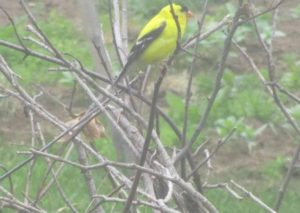
An Eastern goldfinch. Brightly colored, so it is a male.
WHITE ORCHID: Faye Bray, a friend from the Outdoor Club of South Jersey, reported a rare white variety of the pink lady-slipper orchid, “Cypripedium acaule,” in the Whitesbog, Burlington County, area of the Pine Barrens. “It’s freaking remarkable,” Faye said. (Unfortunately, we could not get a photograph for “Garden and Afield.”)
TURTLES: Turtles have been laying eggs, meaning females have been moving around. On my trip to and from New Orleans, I saw a half-dozen or so dead along the Interstate highways, apparently struck by vehicles. Up here in the Midlands, I have heard of various encounters with turtles. One, a person moved a box turtle, “Terrapene carolina,” to water. Wait, a box turtle is a land animal. Two, another person moved a snapping turtle, “Chelydra serpentina,” to a pond, possibly interrupting its egg-laying. So, my advice is, unless there is a compelling reason, leave wildlife alone. Generally, it knows what it is doing, it does not need humans to mess up its life.
TICKS: Ticks are bad this year. Essentially, they cling to vegetation and wait for a mammal to brush by them, then they attach. We have three ticks locally: deer tick, “Ixodes scapularis”; lone star tick, “Amblyomma americanum,” The female is easily distnguishable by the light-colored dot on her back; wood tick, also known as the dog tick, “Dermacentor variabilis.”
Get a tick ID pocket card. It will show the size and colors of not only these ticks, but in different stages of development. See http://www.tickencounter.org/tick_identification/guide.
There is no need to panic. Tick-borne diseases are relatively rare — I mean, if everyone in range of a tick, or even bitten by a tick, were to get sick, there would be a very sick population. However, be vigilant. In the yard, keep grass trimmed. If in the woods, take precautions by dressing properly. (If I am wearing long pants, for example, I tuck them in my socks.) And check for ticks on one’s body. When coming in from the woods or other places ticks are likely, wash the clothes and bathe as soon as possible.
If a tick is crawling on oneself, simply flick it off — It may take a few tries. If one is attached, take tweezers and grab it behind the head and pull it out. Then flush it down the toilet, throw it in a fire, or, if needed for observation, put it with an alcohol-doused cotton swab in a closed container.
If bitten, observe the bite for abnormalities, such as the Lyme Disease bull’s eye, seek medical help if concerned. The big tick disease locally is Lyme. However, New Jersey is now watching for Powassan virus.
My yard is wildlife-friendly and I take no special precautions in the yard, other than observing my clothes and body. I am always in the woods and fields, I found one tick on my body this season, but 10x or 20x that on my clothes — the point being, notice them before they get on one’s body.
Regarding the yard, keep the grass cut. I have tall-grass wildlife patches in my yard and have not found a tick on me yet while doing yardwork, etc. I would be more concerned with cats and dogs bringing them inside.
If you look them up online, use the scientific name, so as not to confuse species and colloquial names.
LETHAL ANIMALS: I would say on a daily basis, the three most lethal animals in the Pine Barens around Helmetta are the tick, mosquito, and pet dog. The former two could do a number for life, while the latter one could be hurtful for the moment.
In the Piedmont region of the Jersey Midlands, I would add copperhead snake, “Agkistrodon contortrix.” In the main Pine Barrens, the rattlesnake, “Croatus horridus.” But the chances of getting bit by either is rare.
Throughout the Midlands, a wandering black bear, “Ursus americanus,” could be a threat – but unlikely. If you see one, stay clear and that should be enough.
YOU SAY “MUSKMELON,” I SAY “MUSHMELON”: My friend Virginia Lamb, who I have turned to for advice (environmental, gardening, and general) over the years, said in reference to my using “mushmelon,” “It’s ‘muskmelon, not ‘mushmelon.’” She is correct, in a more formal sense. But I am correct, too, in a more informal way. So, I responded in an e-mail, “Local colloquialism = mushmelon. I use that only in my blog. Normally, when I talk, I say cantaloupe. (Kind of like the colloquialism “garden snake” for “garter snake.)” Yes, we are all talking cantaloupe.
SCIENTIFIC NAMES: My use of scientific names also has prompted some discussion. Sunil Nair, who has followed my Internet nature posts, said, “Love the fact that you write the genus names, too.” But Virginia Lamb noted, “Just a note on reader preference: I feel the Latin names interrupt the folksy flow of the prose and would prefer they be noted at the end. But that may just be me.” I am considering Virginia’s point. As for using scientific names, I do it so there is no question what is being discussed. “Swamp pink” could be the “Arethusa bulbosa” orchid or it could be the “Helonias bullata” lily. But a scientific name is a scientific name is a scientific name.
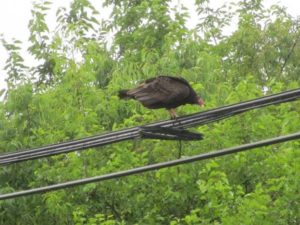
A turkey vulture, “Cathartes aura,” sits on a roadside utility line in Monroe after I spooked it when it was eating a dead ground hog, “Marmota monax.” Here, it is easily identified by its red head. Turkey vultures are commonly seen, soaring in a circle, their wings tipped into a V.
SUNRISE/SUNSET: For June 18, Sunday, to June 24, Saturday, the sun will rise between 5:25 and 5:30 a.m. and set about 8:30 p.m.
DATE TO KEEP IN MIND, JUNE 21: The longest daylight of the year is Wednesday, June 21, the summer solstice, when the sun rises at 5:28 a.m. and sets at 8:31 p.m. After June 21, daylight gets shorter.
DATE TO KEEP IN MIND, JUNE 24: St. John the Baptist Day. Sophie Majka, a neighbor who died March 8 at 92-years-old, had told me blueberries are ready to pick in the Pine Barrens around Helmetta on St. John’s Day, June 24. So, that is a target I look to.
WEATHER: The National Weather Service forecasting station for the area is at http://www.weather.gov/phi/.
SOURCES: As you can see, I have already mentioned various sources of information. Additionally, I enjoy listening to Mike McGrath’s “You Bet Your Garden” radio show on WHYY, 90.9 FM, out of Philadelphia – or on the Internet at http://whyy.org/cms/youbetyourgarden/. I also read Sally McCabe’s “In the Garden, It’s Time To…” column in the Philadelphia Inquirer newspaper, or on the Internet at philly.com.
MORE N’AWLINS FLAVOR IN HELMETTA: Why do I love traveling in the South? Maybe because I am a boy of the South – South Middlesex County. And my local roots go back to Helmetta, whose founder, for lack of a better term, George Washington Helme, was a Confederate military officer. Although a native of Kingston, Pennsylvania, Helme was a New Orleans resident during the Civil War. After the war, he came up to Helmetta, where his wife’s, Margaret Appleby Helme’s, family had a snuff mill operation – one that George would eventually take over. The George W. Helme Snuff Mill provided my family with work for approximately 75 years, from circa 1900 to 1976. The mill stopped manufacturing snuff in 1993 and, now, it is being converted into housing.
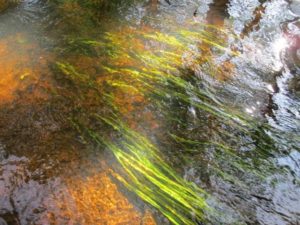
Looking into sunlit Manalapan Brook, here between Helmetta and Jamesburg.
Joe Sapia, 60, is a lifelong Monroe resident. He is a Pine Barrens naturalist and an organic vegetable-fruit gardener.
He gardens the same backyard plot as did his Italian-American father, Joe Sr., and his Polish-immigrant, maternal grandmother, Annie Poznanski Onda. Both are inspirations for his food gardening. Joe is active with the Rutgers University Master Gardeners/Middlesex County program. He draws inspiration on the Pine Barrens around Helmetta from his mother, Sophie Onda Sapia, who lived her whole life in these Pines, and his Grandma Annie. Joe’s work also is at @JosephSapia on Twitter.com, along with Facebook.com on the Jersey Midlands page.
The July 17 LRWP meeting will be held from 10-noon in the Middlesex County Planning Offices at 75 Bayard Street, New Brunswick, NJ – 5th floor mid-size conference room.
We welcome Professor JeanMarie Hartman and her students Sophie Benaroyan, BoYoung Park, and Colin Marx who will speak on the following topics:
“Factors Affecting Infiltration Rates in the Lower Raritan Watershed” (Benaroyan)
“Exploring the relationship between forest cover and water quality in New Jersey’s Lower Raritan Watershed” (Park)
“Forests and Land Cover in the Raritan Basin” (Marx)
Parking is validated for those parking on floors 5 and higher in the RWJ Wellness Parking Deck located at 95 Paterson Street, New Brunswick, NJ 08901. Be sure to bring your ticket to the meeting for validation.
For more information contact Heather: hfenyk AT lowerraritanwatershed DOT org
Article and photos by Joe Sapia
Note: The yard references are to my house in the section of Monroe between Helmetta and Jamesburg in South Middlesex County. My yard is in a Pine Barrens outlier on the Inner Coastal Plain, the soil is loamy, and my neighborhood is on the boundary of Gardening Zones 6b (cooler) and 7a (warmer). Afield references are to the Pine Barrens around Helmetta, unless otherwise noted. Photographs are for the period covered, unless otherwise noted.
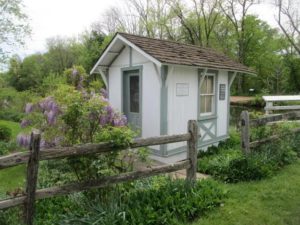
In the Delaware and Raritan State Park, the historic bridgetender station, circa 1830, and garden at Blackwells Mills in Franklin/Somerset County.
GARDEN AND YARD: In my food garden, peeking through the soil are cool weather vegetables of lettuce and carrots. I had not seen any noticeable sign of peas coming up, but Cranbury/Middlesex County farmer Roy Reinhardt advised me to be patient; He was right, there they were a few days later. Wild onions, “Allium canadense,” are coming up in my lawn; If only I enjoyed onions more than I do, I would have a nice bounty.

Wild onions growing in the yard.
RAIN: The rain May 5, Friday, was drenching. Kathy Krygier of Krygier’s Nursery in South Brunswick/Middlesex County reported about 1.75 inches. Other reports from the Jersey Midlands, via the wunderground.com website, include Lambertville/Hunterdon County, 1.63 inches; Somerville/Somerset County, 1.16 inches; the Mill Lake Manor section of Monroe, 2.05 inches; Little Silver/Monmouth County, 2.02 inches; Miller Air Park in Berkeley/Ocean County, 2.63 inches; the Chatsworth area/Burlington County, 1.62 inches; and Ewing/Mercer County, 1.63 inches.
UPCOMING FOOD GARDEN DATES: For planting the warm season crop, my rule of thumb is May 20 (in a warm season) to June 1 (in a cooler season), with steady overnight temperatures of 55 or higher. Some planters go by Mother’s Day (this year, May 14), some go by May 15. Helmetta farmer Timmy Mechkowski says after the May full moon – this year, this Wednesday, May 10, the Full Corn-Planting Moon.
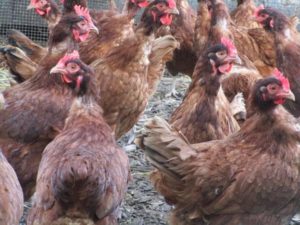
Rhode Island red chickens at the Mechkowski Farm in Helmetta.
INTERNATIONAL SPACE STATION: Possible sightings of the ISS are May 8, Monday, 4:47 a.m. to 4:50 a.m, tracking west southwest to north northeast; May 9, Tuesday, 3:57 a.m. to 3:59 a.m., south to east northeast; May 10, Wednesday, 4:40 a.m. to 4:44 a.m., west to north northeast; May 12, Friday, 4:32 a.m. to 4:36 a.m., west northwest to north northeast. Caution: One needs a clear sky and, at times, a clear view well above the horizon.
EGRET: I have noticed a great egret, “Ardea alba,” fly by my house two or three times in recent weeks, along with once about 1-1/2 miles away. I suspect it is the same bird. Just an interesting sighting.
TURKEY: A wild turkey, “Meleagris gallopavo,” greeted me when I turned onto my street.

A wild turkey in the neighborhood.
TICKS: Reports are coming in about ticks being out with a vengeance in New Jersey. I, for example, have pulled deer ticks, “Ixodes scapularis,” and lone star ticks, “Amblyomma americanum,” off my clothes. From Chris Bevins, “How are you making out with ticks? They are ferocious this year and first time I’m seeing lone star ticks in abundance.” And Frank Ulatowski says he had about a dozen on him or his clothes after being up at the Delaware Water Gap area.
PINE BARRENS AROUND HELMETTA: Pink lady-slipper orchids, “Cypripedium acaule,” are coming into bloom. Flowering dogwood, “Cornus florida,” remains in bloom. Pitch pine, “Pinus rigida,” have long “candles” of new growth. Cinammon fern, “Osmunda cinnamomea,” is in its fiddlehead state and unfurling. Northern gray treefrogs, “Hyla versicolor,” continue calling vociferously. Spring peeper treefrogs, “Pseudacris crucifer,” continue calling. Sunfish, genus “Lepomis,” guarded their nests at Helmetta Pond. Antlion larvae, “Hesperoleon abdominalis,” had pits to capture ants. And I captured a nice photo of some kind of dragonfly in the woods.
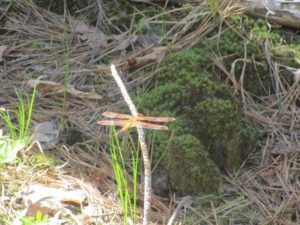
A dragonfly at Jamesburg Park/Middlesex County.
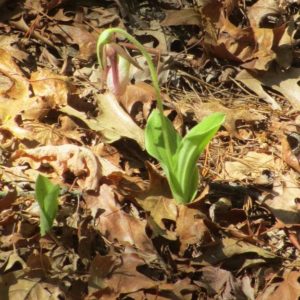
A pink lady-slipper orchid in bloom, right. Left, lady-slipper leaves poking through the ground.
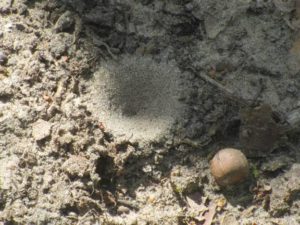
The pit of an antlion larva, or doodlebug. The larva sits in a pit awaiting a meal of an ant. The larva eventually evolves into a flying insect. To put the size of the pit in perspective, that is an acorn sitting nearby.
DELAWARE AND RARITAN CANAL: I visited a Franklin/Somerset County section of the D&R Canal State Park, specifically the area between Route 518 and Blackwells Mills. Various animals were active — great blue heron, “Ardea herodias”; Gray catbird, “Dumetella carolinensis”; redbelly turtles, “Pseudemys rubriventris.” Spring beauties, “Claytonia virginica,” remain in bloom. I saw as-big-as-my-forearm poison ivy, “Toxicodendron radicans” — “Hairy rope, don’t be a dope!” As a kid, I could touch it and not get a rash, but twice I got it bad as an adult years ago — perhaps it was because of the hot days, me sweating, my pores open. Now, I take no chances!
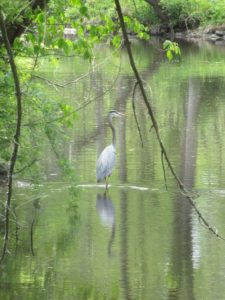
A great blue heron in the D&R Canal.
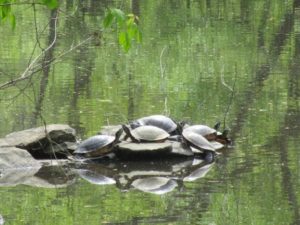
Basking redbelly turtles in the D&R Canal.
TURTLES CROSSING ROADS: A heads-up for turtles crossing roads. There has been a lot of reported movement lately. If driving, watch out for them. If trying to move them, one, do it safely and, two, move the turtle in the direction it was traveling. (For snapping turtles, “Chelydra serpentina,” BE CAREFUL. Some Piney lore, only lightning or the setting sun will make a snapper let go. Me, I use a grain shovel I keep in my Jeep to move snappers across roads.) I was driving through Pigeon Swamp in South Brunswick/Middlesex County recently and saw what I think was an eastern painted turtle, “Chrysemys picta,” crossing a road. By the time I turned around to move it, it was gone.
SUNRISE/SUNSET: For the week of May 7, Sunday, to May 13, Saturday, the sun will rise at about 5:45 a.m. and set at about 8:05 p.m.
WEATHER: Go to the National Weather Service forecasting station for the area, http://www.weather.gov/phi/.
UPCOMING AFIELD DATE: The first soaking rain around May 15 should green up the woods for the season.
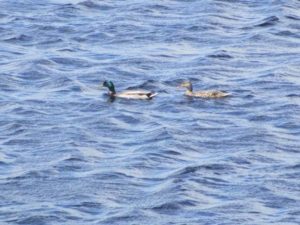
Mallards, “Anas platyrhynchos,” at Helmetta Pond. Left, the colorful male, and, right, the more drabby, brown female.
Joe Sapia, 60, is a lifelong Monroe resident. He is a Pine Barrens naturalist and an organic vegetable-fruit gardener.
He gardens the same backyard plot as did his Italian-American father, Joe Sr., and his Polish-immigrant, maternal grandmother, Annie Poznanski Onda. Both are inspirations for his food gardening. Joe is active with the Rutgers University Master Gardeners/Middlesex County program. He draws inspiration on the Pine Barrens around Helmetta from his mother, Sophie Onda Sapia, who lived her whole life in these Pines, and his Grandma Annie.
The following are the headlines on our watch list:
National Monuments Under Threat: On April 26 President Trump signed an Executive Order to roll back the Antiquities Act, which could change National Monument designation (and the protections that that designation affords) for our National Monuments.
Offshore Drilling EO: On April 28 President Trump signed an Executive Order to expand offshore oil and natural gas drilling. The Order instructs the Interior to review ways to take down barriers to drilling, including in the Atlantic.
Marches for Science and Climate: Throughout April tens of thousands of people took to the streets in over 600 communities to celebrate science and its critical role in both society and policy, and to bring attention to the science that underscores our understanding of climate change.
Please join us for our May visual habitat assessment training with the LRWP and WMA9 Americorps Watershed Ambassador Katee Meckler! (Here’s more on the LRWP’s water quality monitoring programs).
This FREE training will run from 9 AM – 1 PM at the Rutgers Cooperative Extension EARTH Center at Davidson’s Mill Pond, located at 42 Riva Avenue in North Brunswick.
We will start the morning with a lecture indoors, and then get out in the field to test our knowledge of streams and stream habitat.
Please wear clothing and footwear that you don’t mind getting wet and dirty.
RSVP required, E-mail Heather: hfenyk AT lowerraritanwatershed DOT org
Water Protectors in Standing Rock, North Dakota protesting the Dakota Access Pipeline brought attention to serious flaws in the federal environmental review and approval process for crude oil and natural gas pipeline projects. The Water Protectors argued that all infrastructure projects need to include a truly comprehensive Environmental Impact Statement (EIS) that evaluates impacts to our natural and cultural assets.
While the federal oversights affecting Standing Rock were particularly egregious, the legacy of compromised Federal Energy Regulatory Commission (FERC) environmental review processes should be of concern to New Jersey residents as well. Oil and gas pipelines already fragment our environment as they crisscross the state. Our Lower Raritan Watershed may be impacted further by the proposed. This project includes a 3.4-mile-long, 26-inch-diameter pipeline loop in Middlesex County, and a 23.4-mile-long, 26-inch-diameter pipeline loop (called the “Raritan Bay Loop”) beginning at the Middlesex County coast and crossing New Jersey and New York State marine waters.
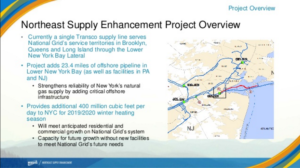
Because the Lower Raritan Watershed Partnership has concerns that the pipeline would have irreversible impacts on our communities, watershed ecology and marine habitat, we joined dozens of other concerned citizens and environmental groups at the April 20 meeting of the Middlesex County Freeholders to encourage elected officials to take action on a project that would pose significant risks. The Home News covered our public statements, and the Middlesex County Freeholder’s response.
And on April 25, the LRWP applied for intervenor status to address the Federal Energy Regulatory Commission (FERC) on the Williams/Transcontinental Application for the Northeast Supply Enhancement (NESE) Pipeline Project (Docket Number CP17-101). Becoming an intervenor provides legal standing in the proceeding, and obligates FERC to address any comments we may submit. The LRWP included the following in our application for intervenor status:
“The Transco Pipeline proposals pose significant risks to our Central New Jersey communities. These projects will solely benefit New York City markets, yet our New Jersey communities would bear significant public health and economic risks – including increased rates of leukemia, lymphomas, respiratory disorders and other diseases – while receiving little or no benefits. We must not expose our local communities to a high-risk proposition with little to no reward.
The Transco Pipeline proposals will harm our environment and the habitat of our Raritan Watershed and Raritan Bay. The building of pipeline infrastructure and the transport of natural gas from the Marcellus Shale region to New York will fragment our natural habitat, and disrupt commercial and recreational marine activities for residents and visitors. Our communities are working hard to restore landscapes destroyed by decades of industrial dumping and toxic pollution, let’s not reverse this positive trend.
The Transco Pipeline proposals are unnecessary. The Transco Pipeline would be a redundant expansion of industrial natural gas infrastructure through our Middlesex County, Somerset County and Bayshore communities. The LRWP recognizes that aging rail, bridge and other infrastructure that currently accommodates fuel transport poses risks that could lead to devastating spills in our waterways. This serious concern that can be addressed by two-pronged strategy: significant investment in the repair and maintenance of our existing infrastructure, and shifting investments to safe, clean renewable energy.
The Transco Pipeline proposals are not what our communities want. The overwhelmingly negative feedback on the project during community meetings has made it clear that this project does not have the support of community residents!”
Article and photos by Joe Sapia
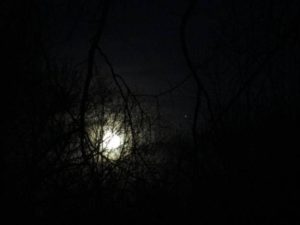
The Full Easter Moon rises over the Manalapan Brook floodplain in Monroe, Middlesex County, on the April 10-11, Monday-Tuesday, overnight. The white speck to the right of the moon is Jupiter.
Author’s note: The yard references are to my house in the section of Monroe between Helmetta and Jamesburg in South Middlesex County. My yard is in a Pine Barrens outlier on the Inner Coastal Plain, the soil is loamy, and my neighborhood is on the boundary of Gardening Zones 6b (cooler) and 7a (warmer).
FIRSTS OF THE SEASON: For the first time this season, I saw a bee, bat, and cabbage white butterfly – all on the same day, April 10. The bee was in my side yard, the cabbage white in my garden, and the bats, both flying over my yard and near woods edge at Manalapan Brook. (Also, it was the first day I heard my attic fan kick in.)

A cabbage white butterfly in my garden, near an oak leaf for a size comparison.
MULCHING TREES: Oh, no, mulch “volcanoes”! Those are the volcano-shaped mulch structures around tree trunks. Mulching is done for a variety of reasons, such as providing moisture and drainage, while serving as a buffer against yard equipment and giving the yard a neater look. But volcanoes are bad for the tree – they can lead to over-moisture and the introduction of disease. So, go for the “doughnut”: creating a doughnut-like circle around the tree, the inner circle having no contact with the tree or its roots, the outer circle 2 to 3 inches of mulch either to the end of the root ball or the tree’s drip line.
MA’S FLOWERING QUINCE: My family is the original owner of my house, going back to 1953. I was born in 1956 and never recall a time without Ma’s flowering quince bush. So, I figure the bush was planted soon after the family bought the property in ’53. This year, the flowering is not looking good, probably because of the warm weather inducing budding, followed by cold weather killing the buds.
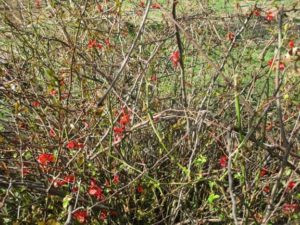
Ma’s flowering quince not looking too good this season, probably because the flowering was affected by the warm temperatures that prompting budding, followed by cold killing the buds.
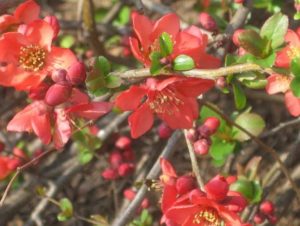
The flowering quince during a nicer bloom in spring, 2012.
FLOWERING AT “THE MASTERS” GOLF TOURNAMENT: The Masters Golf Tournament played annually in Augusta, Georgia, is known for its flowering beauty. This year, though, Augusta had a warm winter followed by cold spring days, prompting an early bloom followed by killing freezes. So, when the Masters was played April 6 to 9, the flowering was not that vibrant.
HELMETTA POND FISHING: Helmetta Pond is a typical Pine Barrens “tea water,” acidic body of water, here in the Spotswood Outlier of the Pines. Joey Slezak, my local go-to science person, fished the Pond April 12 and caught pickerel and largemouth bass.
BIRDS SINGING: Listen to the spring songs of birds, probably asserting territory or seeking mates. This week, I heard them as early as about 5:15 a.m., or more than an hour before sunrise.
SNORTING DEER: On the overnight of the full moon, I walked across the street to Manalapan Brook, spooking some deer. At least one gave out a few loud snorts, probably alerting other deer of my presence and maybe trying to spook me. The snort is sort of spooky, but something I get a kick out of, wildlife communicating because of me. Then, the deer bolted.
MA’S FLOWERS: Ma died at 81-years-old in 1995, but, come spring, her front yard daffodils and crocuses continue blooming.
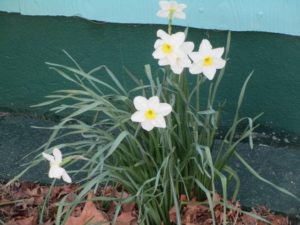
Ma’s daffodils, still blooming in the front yard, 22 years after Ma died.
MORE NATURE NEWS FROM THE JERSEY MIDLANDS: See the observations made by naturalist Bill Simmons, http://www.inaturalist.org/observations/wsimmons. Bill is the retired environmental coordinator for the Monmouth County Health Department. He also is at @BillSimmonsNJ on Twitter.com.
SUNRISE/SUNSET: For the week of April 16, Sunday, to April 22, Saturday, the sun will rise at about 6:07 to 6:15 a.m. and set at about 7:38 to 7:44 p.m.
WEATHER: Go to the National Weather Service forecasting station for the area, http://www.weather.gov/phi/.
— Joseph Sapia
2017, April 15, Easter Saturday,
Joe Sapia, 60, is a lifelong Monroe resident. He is a Pine Barrens naturalist and an organic vegetable-fruit gardener. He gardens the same backyard plot as did his Italian-American father, Joe Sr., and his Polish-immigrant, maternal grandmother, Annie Poznanski Onda. Both are inspirations for his food gardening. He draws inspiration on the local Pine Barrens from his mother, Sophie Onda Sapia, who lived her whole life in these Pines, and his Grandma Annie.
Article and photos by Joe Mish
RAINFALL: It rained about 2.5 inches in the New Brunswick-Trenton area at the end of last week. So, it will be interesting to see what this week’s drought maps say.
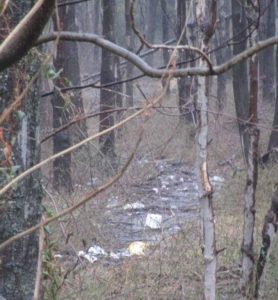
Garbage floating in a Monroe, Middlesex County, drainage ditch
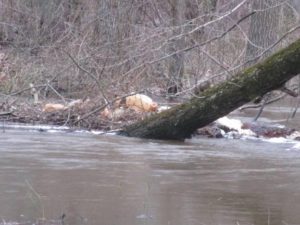
Garbage caught on a tree snag
in Manalapan Brook, Monroe, Middlesex County
NON-POINT SOURCE POLLUTION: During and after the week’s rains, the flow of non-point source pollution was obvious in our waterways. The cost-free way of dealing with it is, do not litter and do not leave stuff out in the yard, then it will not float into waterways.
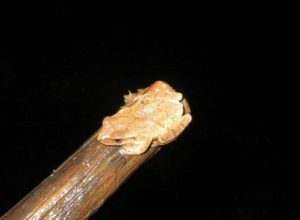
A spring peeper treefrog, found in the Manalapan Brook floodplain
FROGS: I walked into the swamp hardwood forest of the Manalapan Brook floodplain between Helmetta and Jamesburg early in the week. The sleigh bells-like sound of spring peeper treefrogs, “Pseudacris crucifer crucifer,” was obvious. I also heard monkey chattering-like sound of wood frogs, “Rana sylvatica.”
RASPBERRIES: I planted five bare-root Burpee seed company Caroline raspberry plants.
GARDEN ZONES: Depending on the source, the area is Garden Zone 6 (cooler) to Garden Zone 7 (warmer). That means our last frost generally is April 15 to 30; Our first frost is generally Oct. 11 to 20. Beyond that, I am playing it safe and sticking with Zone 6 for my Helmetta area, Middlesex County, home, although the area becoming a solid Zone 7 because of global warming is likely just around the corner.
OUTDOOR PLANTING FOR SUMMER VEGETABLES AND FRUITS: My rule of thumb is May 20 if it is a warm to normal and, if it is cooler, wait to June 1.
PREPARING PLANTS INDOOR: This year, though, I am trying something new, sowing plants indoors before the outside plant dates. So, I am experimenting with Kaleidoscope Blend Organic and Touchon carrots, Iceberg A lettuce, and Sugar Snap peas, all Burpee, which I began sowing about March 5. I added Rutgers tomatoes about March 25. I plan on sowing more tomatoes – Brandywine Red and Red Cherry, both Lake Valley brand – indoors in the next day or so.
HUMMINGBIRDS: Get the hummingbird feeders up by about April 15 to attract the early “scout” birds and they hopefully will lead later-arriving hummingbirds to the feeders.
NIGHT SKY: http://www.skyandtelescope.com/observing/sky-at-a-glance/this-weeks-sky-at-a-glance-march-31-april-8/.
SUNRISE/SUNSET: Approximate times are April 2, Sunday, 6:40 and 7:23 Eastern Daylight Time; April 3, Monday, 6:38 and 7:25; April 4, Tuesday, 6:36 and 7:26; April 5, Wednesday, 6:35 and 7:27; April 6, Thursday, 6:33 and 7:28[ April 7, Friday, 6:31 and 7:29; an April 8, Saturday, 6:30 and 7:30.
WEATHER: Local weather forecasts are available at http://www.weather.gov/phi/.

Carnegie Lake near the Kingston dam
on the boundary of Mercer, Middlesex, and Somerset counties
Joe Sapia, 60-years-old, grew up and lives in the Pine Barrens around Helmetta, where his family has resided for more than 100 years. He can be reached at Snufftin@aol.com or at P.O. Box 275, Helmetta, 08828.
Article and photos by Joseph Sapia
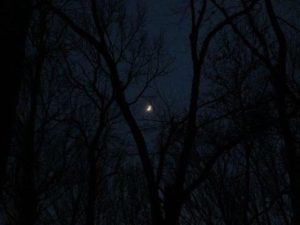
Above the Manalapan Brook floodplain, a crescent moon waxed toward December’s Full Long Nights Moon

Christmastime in Fair Haven, Monmouth County
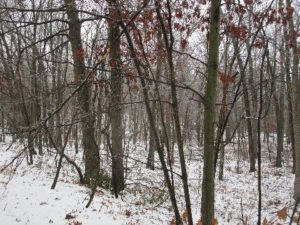
Snowfall of 1-1/2 inches December 17 in the Jamesburg Park Conservation Area, Middlesex County
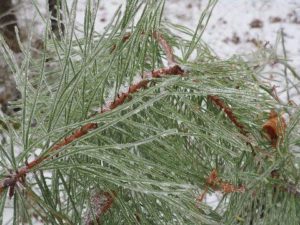
Ice builds up on the needles of a pitch pine, Pinus rigida, the common tree of the New Jersey Pine Barrens. Here, in the Jamesburg Park Conservation Area in the Pine Barrens around Helmetta.
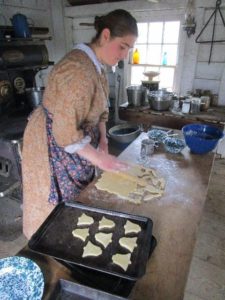
Christmastime at historic Longstreet Farm, the Monmouth County Park System’s living history farm, replicating the late 1800s in Holmdel. Here, baking cookies the old-fashioned way.
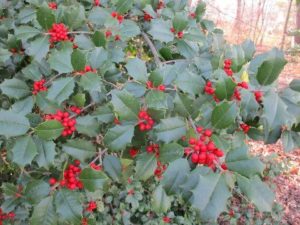
Holly in my neigbhorhood in Monroe, Middlesex County.
Joe Sapia, 60-years-old, grew up and lives in the Pine Barrens around Helmetta, where his family has resided for more than 100 years. He can be reached at Snufftin@aol.com or at P.O. Box 275, Helmetta, 08828.
Article and photos by Joseph Sapia

Shekiro’s Pond in Helmetta
Joey Slezak grew up in South Jersey, but he has multi-generational roots in the Pine Barrens around Helmetta and has lived in his parental grandparents’s former house in Helmetta while studying at Rutgers University in New Brunswick. In his own right, Joey is a meteorology student at Rutgers, an outdoorsman, and, importantly to me in the outdoors, my go-to science guy.
I was looking forward to walking afield with him – perhaps not on as cold a day as February 18, 2015. Minus 1 degree at dawn and 9 degrees when I left my house about two hours later. But between our schedules, we had to take advantage of this opportunity, cold or not. Plus, we are woodsmen from Helmetta of tough local Polish stock. So, we plunged into the approximately 15 degrees when we finally started walking before 10 a.m.
A woodpecker hammered away. A few inches of snow covered the ground – on the surface, it was fluffy — and clung to trees.
“You could see the snow fall from the trees, these little flakes go by,” said Joey, 22-years-old at the time and working on his bachelor’s degree in meteorology.
On this day, we would spend much time in wetlands, including an Atlantic white cedar swamp being threatened by invasive phragmites.
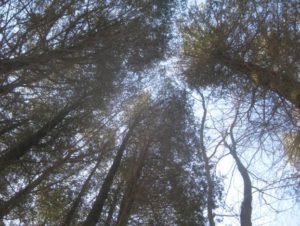
Looking skyward from the Atlantic white cedar swamp
“This is probably as secluded as you could be in these woods,” I said.
It was very quiet, until a jet airplane flew by.
“The final approach to Newark Airport comes over us,” Joey said.
Despite the cold, I was surprisingly warm.
“Once you heat up your clothes, there’s no wind to dissipate it,” Joey said. “(And) you’re dressed for it.”
I was dressed in long underwear, bottoms and tops; covered with a sweater and windbreaker jacket, all made of materials to wick sweat.
Joey pointed out hoar frost, a crystallized coating of frost. With the hoar frost, Mother Nature worked her art on any icy surface of water and on blades of vegetation.

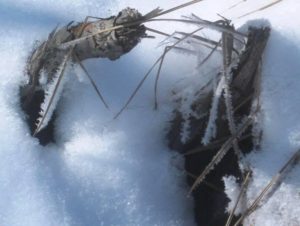
Mother Nature’s artwork: hoar frost.
Here and there, we were in danger of breaking through the swamp ice. I went up to my shins at one point, up to my thigh at another. Joey noted how he could smell the swamp when I broke through.
As we walked, we noticed evidence of the day’s low humidity – in the clarity and blueness of the sky.
“Not a cloud in the sky (hardly), a bluebird day,” said Joey, who, now in 2017, is working on his master’s degree in atmospheric science.
As we walked a sand road, we noticed fallen trees, lying northeast to southwest.
“That’s probably coastal,” Joey said, meaning a storm out of the east, rather than in the normal flow of wind from the west.
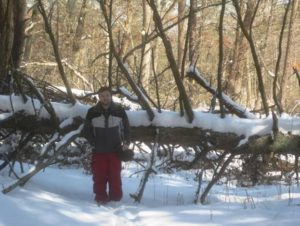
Joey Slezak at a treefall.
Perhaps the highlight of the day was hearing the call – a running-a-finger-along-the-teeth-of-a-comb sound — of a New Jersey chorus frog. This frog is an early caller, breeding as early as February, according to New Jersey Division of Fish and Wildlife literature.
“That sun’s getting warm,” Joey said.
By the time we ended the walk at lunchtime, the temperature was about 30.
“I had a lot of work to do, a lot of stress,” Joey said. “It felt pretty good to get out there.”
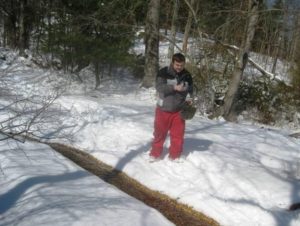
Joey Slezak at a small stream
Joe Sapia, 60-years-old, grew up and lives in the Pine Barrens around Helmetta, where his family has resided for more than 100 years. He can be reached at Snufftin@aol.com or at P.O. Box 275, Helmetta, 08828.







































